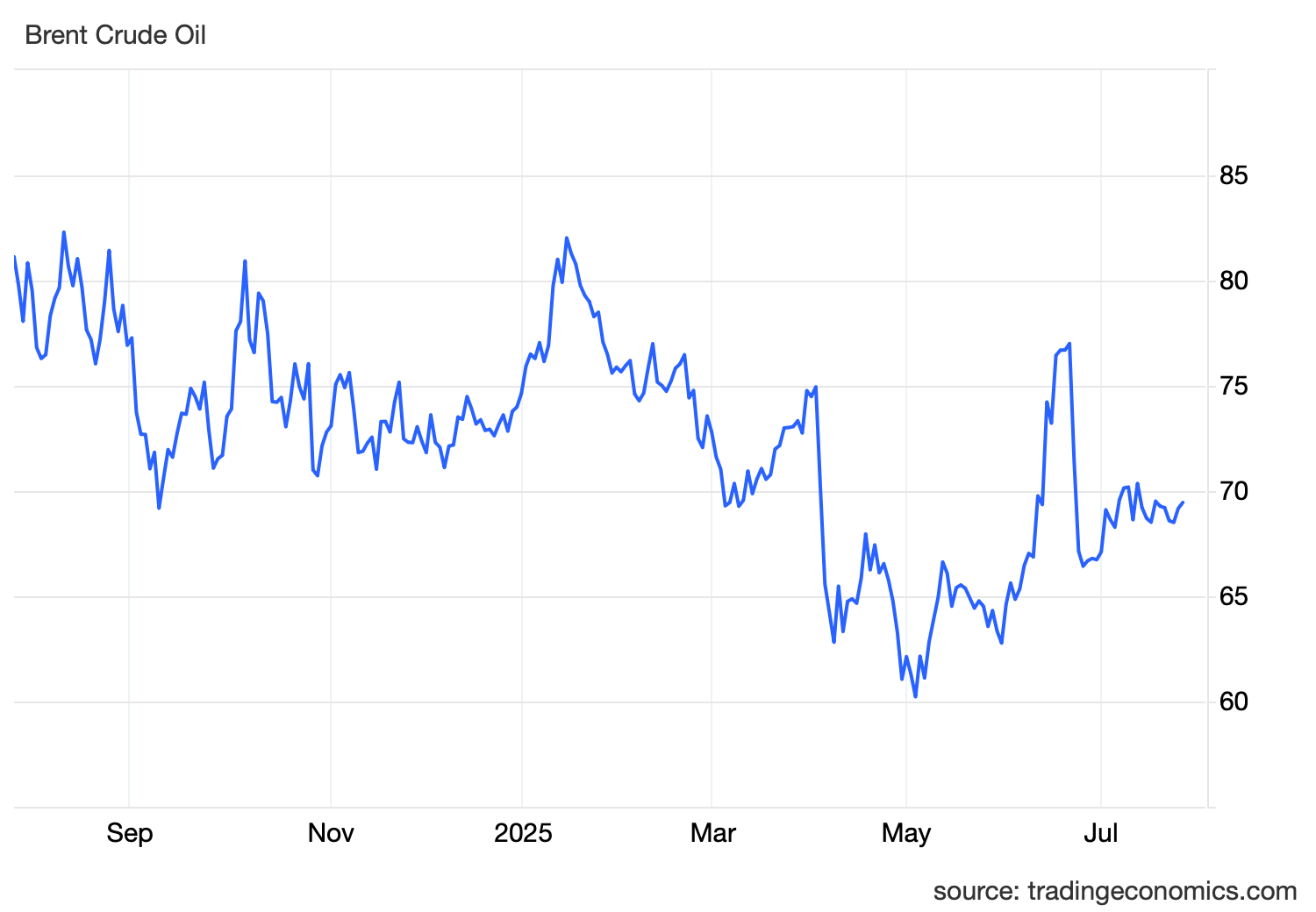Brent Crude Falls to $69.2 Amid Tariff Fears and OPEC+ Output Hike, Offset by Geopolitical Tensions
Brent crude oil futures declined to $69.2 per barrel on Tuesday, easing from a two-week high as markets digested a complex mix of bearish trade policy signals and supply-side developments. The latest retreat reflects growing concern over the global demand outlook following President Donald Trump’s announcement of aggressive new tariff measures, coupled with a surprisingly large production increase agreement from OPEC+. Still, geopolitical risks—particularly renewed Houthi attacks on Red Sea shipping lanes—provided a counterbalance, helping to limit further losses.
The primary bearish impulse came from tariff-related demand fears. On Monday, President Trump unveiled the first of several anticipated trade policy declarations, issuing formal letters that pave the way for 25% tariffs on imports from major trade partners, including Japan and South Korea, to take effect on August 1. This move significantly heightens trade tensions in the Asia-Pacific region, raising concerns about industrial production, automotive exports, and energy demand across some of the world’s most oil-intensive economies. As these economies absorb the inflationary and growth-slowing effects of the tariffs, oil consumption forecasts for Q3 and Q4 may be revised downward, particularly for diesel and jet fuel.
Layered onto the demand fears is a bearish supply shock from the production side. On Saturday, OPEC+ members agreed to raise output by 548,000 barrels per day (bpd) in August, marking the fourth consecutive monthly hike and exceeding market expectations. This output restoration accounts for nearly 80% of the 2.2 million bpd in voluntary cuts agreed upon earlier in the year by eight OPEC nations—including Saudi Arabia, the UAE, and Iraq—as part of a coordinated effort to stabilize global oil markets. The decision to ease voluntary cuts at a faster pace suggests that key producers are now prioritizing market share amid weakening demand signals, potentially tipping the supply-demand balance toward a glut in the latter half of 2025.
Analysts at Goldman Sachs and Wood Mackenzie have flagged this combination of weakening Asian demand and rising Middle Eastern supply as a flashpoint for price correction. According to internal models from JP Morgan Commodities, global inventories could swell by 1.1 million bpd in Q4 2025, particularly if Chinese and Indian refinery intake does not pick up in tandem. Refining margins in Asia have already contracted by 12% since May, making further crude uptake less attractive without downstream demand support.
Despite the strong headwinds, oil prices avoided a steeper decline due to renewed geopolitical disruptions in a critical maritime corridor. On Tuesday, Yemen’s Houthi rebels launched a second attack this month on commercial shipping vessels transiting the Red Sea, escalating concerns about the security of global energy supply routes. The Bab el-Mandeb Strait, which connects the Red Sea to the Gulf of Aden, is a chokepoint through which nearly 6 million bpd of oil and refined products pass daily. While no major shipping losses have yet been confirmed, insurers have begun to raise premiums on Red Sea routes, and several shipping companies have already rerouted vessels through the Cape of Good Hope—adding cost and time to global oil logistics.
The geopolitical backdrop has added a premium of $2–$3 per barrel to Brent prices over the past week, as traders hedge against the possibility of prolonged shipping disruptions or broader regional escalation. The risk calculus has become particularly complex, as multiple maritime zones—including the Strait of Hormuz and the South China Sea—remain subject to naval stand-offs and diplomatic friction. If further attacks in the Red Sea escalate or involve major flag-state vessels, Brent prices could rebound sharply despite the current oversupply narrative.
Looking forward, the trajectory for Brent crude will hinge on several variables: the actual implementation and retaliatory fallout of U.S. tariffs; OPEC+ compliance with output targets; the pace of inventory accumulation in OECD economies; and real-time geopolitical risks to energy flows. Without a resurgence in demand—particularly from Asia—or a renewed pause in OPEC+ supply expansion, Brent may test the $66–$67 support zone in the coming weeks. However, upside scenarios could be driven by shipping disruptions or surprise drawdowns in U.S. or Chinese inventories.
In conclusion, the decline in Brent crude to $69.2 per barrel reflects a bearish recalibration driven by protectionist trade policy, a larger-than-expected OPEC+ supply boost, and softening global demand projections. While geopolitical tensions in the Red Sea have helped floor prices temporarily, the oil market remains on a knife-edge—susceptible to both supply-side flooding and transport-based volatility. Traders, refiners, and policymakers will need to remain agile as the balance of risks pivots between economic friction and geopolitical fragility.
Sources
OPEC Secretariat. (2025). Monthly Oil Market Report – July 2025.
U.S. Energy Information Administration (EIA). (2025). Global Petroleum Inventory Outlook. [https://www.eia.gov]
Reuters. (2025). Brent Drops on OPEC+ Output Hike and Trade Tensions.
Bloomberg. (2025). Trump Tariffs Target Japan, South Korea; Oil Markets React.
Goldman Sachs Commodities Research. (2025). Oil Demand Scenarios – H2 2025.
MarineTraffic & Lloyd’s List. (2025). Red Sea Shipping Disruptions – Security Bulletin.
